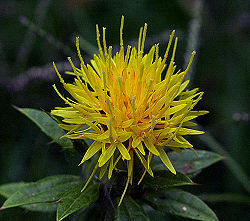Typical yield
1.2 t/ha
Varieties
1
Pest/Disease
1
Seasons
1
Profile
- Growth habit
- annual
- Lifecycle (days)
- 100-140
- Primary uses
- Oilseed; dye
- Pollination
- insect
- Origin / distribution
- SW Asia; semi-arid
Environment
Climate
Temp optimal
15–28 °C
Rain optimal
300–500 mm/yr
Altitude
0–2200 m
Soil
pH optimal
6.5–7.5
Soil type
Well-drained; tolerates salinity
Farmer Guide
Row spacing
50 cm
Plant spacing
20 cm
Depth
3 cm
Seed rate
15 kg/ha
Nursery days
Nutrient Schedule
| # | Stage | DAP | Product | Rate | Targets (kg/ha) | Notes |
|---|---|---|---|---|---|---|
| 1 | Basal | 0 | DAP 18-46-0 | 70 kg/ha | N: —, P₂O₅: —, K₂O: — | |
| 2 | Topdress | 30 | CAN 26% N | 80 kg/ha | N: —, P₂O₅: —, K₂O: — |
Nutrient Requirements
| Nutrient | Stage | Amount | Unit |
|---|---|---|---|
| N | Basal | 30 | kg/ha |
| P₂O₅ | Basal | 20 | kg/ha |
| K₂O | Basal | 20 | kg/ha |
| N | Topdress | 20 | kg/ha |
Images

| Name | Country | Maturity | Traits |
|---|---|---|---|
| Local Safflower | KE | 120 | Drought tolerant |
No fertilizer recommendations yet.
| Name | Type | Symptoms | Management |
|---|---|---|---|
| Aphids | pest | Honeydew; stunting | Natural enemies; spot sprays |
| System | Typical | Min | Max | Notes |
|---|---|---|---|---|
| rainfed | 1.2 | 0.5 | 2 |
| Country | Region | Planting | Harvest |
|---|---|---|---|
| KE | Semi-arid | Mar–Apr | Jul–Sep |
| Country | Region | Suitability |
|---|---|---|
| KE | Semi-arid | High |
